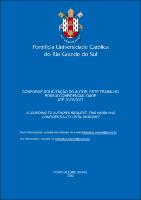| Share record |


|
Please use this identifier to cite or link to this item:
https://tede2.pucrs.br/tede2/handle/tede/10407| Document type: | Dissertação |
| Title: | Influência da unidade de luz, tempo de fotoativação e sistema de polimento na rugosidade superficial de resinas compostas |
| Author: | Bueno, Cheyenne Coscia |
| Advisor: | Burnett Junior, Luiz Henrique |
| Abstract (native): | Objetivo: Avaliar a influência de unidades de luz LED, tempo de fotopolimerização e sistema de polimento na rugosidade superficial de duas resinas compostas. Materiais e métodos: As resinas compostas avaliadas foram Vit-l-escence e Tetric N-Ceram. Oito amostras de 2mm de profundidade e 4mm de diâmetro foram confeccionadas para cada grupo. As amostras foram fotopolimerizadas por 10 ou 40 segundos utilizando Bluephase G2 ou VALO Grand e armazenadas em água destilada por 24 horas. Após o período de armazenagem, as amostras receberam tratamento de superfície com disco Soflex. O protocolo de polimento foi realizado com os sistemas Jiffy Polisher ou A.S.A.P. A rugosidade superficial média foi mensurada com auxílio de rugosímetro em três momentos: inicial, após aplicação de disco soflex e final. Resultados: O sistema de polimento (p=0,019) e tipo de unidade de fotoativação (p=0,0001) apresentaram influência neste estudo. O VALO promoveu menores valores de rugosidade com diferença estatística significante para Bluephase G2. Em relação ao Bluephase G2, a resina Vit-l-escence fotoativada por 10 segundos apresentou maior valor de rugosidade média quando comparada a Vit-l-escence fotoativada por 40 segundos e Tetric N-Ceram fotoativada por 10 segundos. A combinação Jiffy-VALO promoveu os menores valores de rugosidade independente da resina composta e tempo utilizados. O grupo Vit-l-escence-10s-Bluephase-ASAP apresentou a maior rugosidade média (0,36 μm) diferindo estatisticamente dos demais grupos. Conclusão: As unidades de fotoativação e o tipo de sistema de polimento podem influenciar na rugosidade superficial das resinas compostas Vit-l-escence e Tetric N-Ceram. A fotoativação com Bluephase G2 por 10 ou 40 segundos promoveu rugosidade similar na resina composta Tetric N-Ceram independente do sistema de polimento utilizado. A resina composta Vit-l-escence apresentou a menor rugosidade superficial quando fotoativada por 40 segundos com VALO e polida com Jiffy Polisher. |
| Abstract (english): | Objective: To evaluate the influence of LED light curing units, curing time and polishing system on the surface roughness of two composite resins. Materials and methods: The composite resins evaluated were Vit-l-escence and Tetric N-Ceram. Eight samples, 2mm thick and 4mm in diameter, were prepared for each group. The samples were light cured for 10 or 40 seconds using a Bluephase G2 or VALO Grand and stored in water distilled for 24 hours. After the storage period, the samples received surface treatment with Soflex disc. The polishing protocol was performed with Jiffy Polisher or A.S.A.P. The average surface roughness was measured with a roughness tester in three moments: initial, after application of Soflex disc and final. Results: The polishing system (p = 0,019) and type of curing unit (p = 0,0001) had an influence on this study. VALO promoted lower roughness values with a statistically significant difference for Bluephase G2. Regarding the Bluephase G2, the Vit-l-escence resin cured for 10 seconds showed a higher average roughness value when compared to Vit-l-escence cured for 40 seconds and Tetric N-Ceram cured for 10 seconds. Jiffy-VALO combination promoted the lowest values of roughness regardless of the composite resin and time used. The Vit-l-escence-10s-Bluephase-ASAP group had the highest average roughness (0.36 μm), differing statistically from the other groups. Conclusion: The light curing units and the type of polishing system can influence the surface roughness of both studied composite resins. The light curing with Bluephase G2 for 10 or 40 seconds promoted similar roughness in the composite resin Tetric N-Ceram regardless of the polishing system used. The Vit-l-escence composite resin showed the lowest surface roughness when cured with VALO for 40 seconds and polished with Jiffy Polisher. |
| Keywords: | Resina Composta Luzes de Cura Dentária Polimento Dentário Dental Polishing Dental Curing Lights Composite Resins |
| CNPQ Knowledge Areas: | CIENCIAS DA SAUDE::ODONTOLOGIA |
| Language: | por |
| Country: | Brasil |
| Publisher: | Pontifícia Universidade Católica do Rio Grande do Sul |
| Institution Acronym: | PUCRS |
| Department: | Escola de Ciências Saúde e da Vida |
| Program: | Programa de Pós-Graduação em Odontologia |
| Access type: | Acesso Aberto |
| Fulltext access restriction: | Trabalho será publicado como artigo ou livro |
| Time to release fulltext: | 60 meses |
| Date to release fulltext: | 30/08/2027 |
| URI: | https://tede2.pucrs.br/tede2/handle/tede/10407 |
| Issue Date: | 29-Mar-2021 |
| Appears in Collections: | Programa de Pós-Graduação em Odontologia |
Files in This Item:
| File | Description | Size | Format | |
|---|---|---|---|---|
| DIS_CHEYENNE_COSCIA_BUENO_CONFIDENCIAL.pdf | CHEYENNE_COSCIA_BUENO_DIS | 188.07 kB | Adobe PDF |  Download/Open Preview |
Items in DSpace are protected by copyright, with all rights reserved, unless otherwise indicated.




